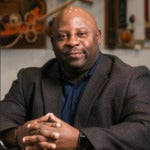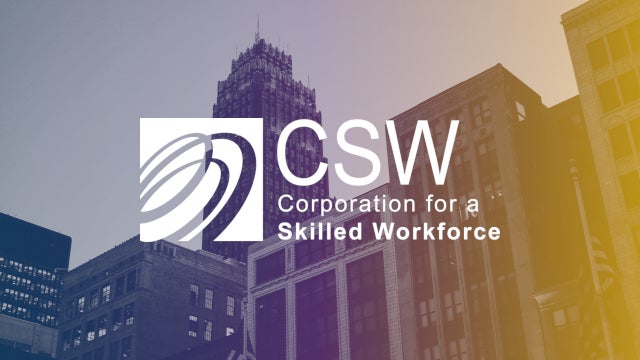 Stephen Tucker is the founding president and CEO of the Northland Workforce Training Center in Buffalo, New York, an EOP Marano Fellow of the Sector Skills Academy, and valued guest faculty for many local Workforce Leadership Academies across the country. For almost twenty years, the Aspen Institute Economic Opportunities Program (EOP) has convened local and national academies that bring together senior leaders from across the workforce ecosystem to learn together about increasing economic opportunity for all. In these interview highlights, EOP Senior Fellows Sheila Maguire and Dee Wallace talk with Tucker about how he not only walks the talk as a leader but gives back to others using lessons learned as a program participant, job developer, economic developer, and champion for community, industry, and the workforce field.
Stephen Tucker is the founding president and CEO of the Northland Workforce Training Center in Buffalo, New York, an EOP Marano Fellow of the Sector Skills Academy, and valued guest faculty for many local Workforce Leadership Academies across the country. For almost twenty years, the Aspen Institute Economic Opportunities Program (EOP) has convened local and national academies that bring together senior leaders from across the workforce ecosystem to learn together about increasing economic opportunity for all. In these interview highlights, EOP Senior Fellows Sheila Maguire and Dee Wallace talk with Tucker about how he not only walks the talk as a leader but gives back to others using lessons learned as a program participant, job developer, economic developer, and champion for community, industry, and the workforce field.
Excerpts from the conversation have been edited for length and clarity. Click here to watch the full discussion or subscribe to our podcast and listen on the go.
What can you tell us about your path to leadership?
Ironically, the way I ended up in workforce development was as a program participant. I actually started off in a program in Cincinnati, with the Urban League of Greater Cincinnati. And I worked for the mayor’s summer youth program. Every city and every county has a summer youth program, teaching workplace skills, expectations, and soft skills and placing participants in unsubsidized employment. So that was my first opportunity. Then, I transitioned to being a job developer for President George W. Bush’s Prisoner Re-Entry Initiative. In this role, I was responsible for placing thousands of returning citizens into employment opportunities, and I was recognized for this in 2008 in the state of Ohio by then-Governor Theodore Strickland. I benefited from my experience as a program participant, as a job developer for youth, and as a job developer for reentry. I then advanced in my career to run my own department and became a vice president, later working at a workforce intermediary called Partners for a Competitive Workforce, managing our work in advanced manufacturing.
What brought you to Buffalo to launch Northland?
When I was in Cincinnati, I worked at a workforce intermediary where I managed our work in advanced manufacturing, aligning education with industry, launching apprenticeship programs, and developing career pathways. The folks in Buffalo heard about the work that we were able to accomplish, and they reached out to me to see if I would be interested in pursuing this opportunity. And what attracted me was the opportunity to really start something from scratch. It’s a $65 million investment — $59 million in revitalizing the facility and $6 million in equipment — and implementing some of those best practices I’ve learned over my career.
What is Northland Workforce Training Center, and how does it fit into your vision for the Buffalo region?
Northland Workforce Training Center was the signature workforce initiative under New York State’s Buffalo Billion. This whole project, which is officially called the Northland Beltline Redevelopment Project, really focuses on place-making: how do we invest in places leveraging assets in the community where we can have the biggest impact on a high number of people? It’s an economic development strategy in addition to a workforce development strategy. We revitalized a 35-acre industrial space adjacent to a once-thriving neighborhood. Just imagine an old industrial space right next to a neighborhood that, back in its heyday, used to employ thousands of people. Literally, thousands of people worked on this campus and used to walk to work. But like many of the Rust Belt cities in Buffalo, starting in the 70s and 80s, some of the factories closed, the jobs dried up, and the area deteriorated. So, this is more than just a training center — it’s an opportunity to revitalize a community that was left behind for so many years. We have other companies creating jobs; we have a banking institution; we have a restaurant where you can get healthy food. They’re all located within the facility.
How did you make the case for a broader vision with the employers and the public sector backing the training center?
When businesses can’t find a qualified workforce, they really have limited options. And a couple of those options are very negative to a community and to an economy. The first option is to automate, which eliminates jobs. Or they can relocate where they can find qualified talent. So, making the case for the businesses was easy. They needed workers to fill these roles. But making the case to the community was also a pretty convincing story because as we are creating jobs and training people for these jobs, we’re now able to create access to opportunities for people who were historically left behind.
Could you share an example of how you’ve worked with business partners in your career?
As a job developer for reentry, initially, I faced a lot of rejection when pitching our program. However, I shifted my approach by partnering with a hiring manager, offering to identify and prepare candidates tailored to their specific job openings. This collaboration resulted in all 20 recommended candidates being hired. This led to invitations to HR association meetings and the development of more employer partnerships. That also led to me being able to provide those partners with job quality strategies in terms of salaries and shifts, coordinating different resources for their employees, and making sure their employees understood the value of their 401(k). So, developing that relationship to where we not only became partners, but those employers became champions advocating for our work and advocating for some of the strategies that we all know make a difference.
What would you encourage other workforce leaders to pay attention to for our field’s development?
The number one thing that I would advocate for is stronger collaboration and stronger partnerships. Do what you do best, partner for the rest. I know where my areas of weaknesses are. It’s okay to develop those weaknesses. It may be an even better strategy to partner with somebody who is stronger in those areas to amplify the work. Also, I believe in getting an understanding of how our work is having an impact in our region and being able to tell those different stories and quantify impact. I’d highlight successes like the Northland Workforce Training Center, which has enrolled over a thousand individuals since 2018, with a program completion rate of over 62%, and 84% job placement with average salaries of around $45,000 a year. When you aggregate those salaries, that’s over $42 million added back into our local economy over the last five years. And with the multiplier, that’s $84 million. We need to tell that story, because we are definitely providing a positive return on investment in New York State. And other workforce development organizations are probably doing similar great work. We need to tell that story a little bit more.
What can the workforce field do to support others who are building careers in workforce development?
I believe that oftentimes in the workforce development field, for some reason, we don’t necessarily invest in the next generation of workers, teaching them those best practices so that they can expand and grow the field. It’s not like when I was a young man, I aspired to be in workforce development or education. I just landed in this role. But now that I’m in these roles, I love helping people. Previously I was an adjunct instructor at a four-year university where I taught organizational development, organizational culture, and organizational behavior. So, I understand the value of lifelong learning, and I understand the value of investing in your colleagues and your employees so that they can develop professionally to provide services to the customers that we are serving. I also understand the need to develop the next generation of talent. And I believe my experience as an instructor, and my experience working with Janice Urbanik (formerly of Partners for a Competitive Workforce), who was a mentor for me personally, all led to me role modeling the behavior. It’s critically important for leaders to role model the behavior, not only for workforce practitioners but for job seekers as well. So, I’m a firm believer in that, and I take that very seriously.
Conclusion
In this discussion, Stephen Tucker not only addresses the pressing demand for skilled labor, but also champions the creation of meaningful careers for individuals within a thriving community. Through his leadership, the Northland Workforce Training Center demonstrates a commitment to sustainable economic growth and the advancement of workers’ well-being, while he demonstrates a commitment to the field of workforce development and its emerging leaders.
Explore the full interview on YouTube or our podcast to learn more about Stephen Tucker’s transformative vision for workforce development.

